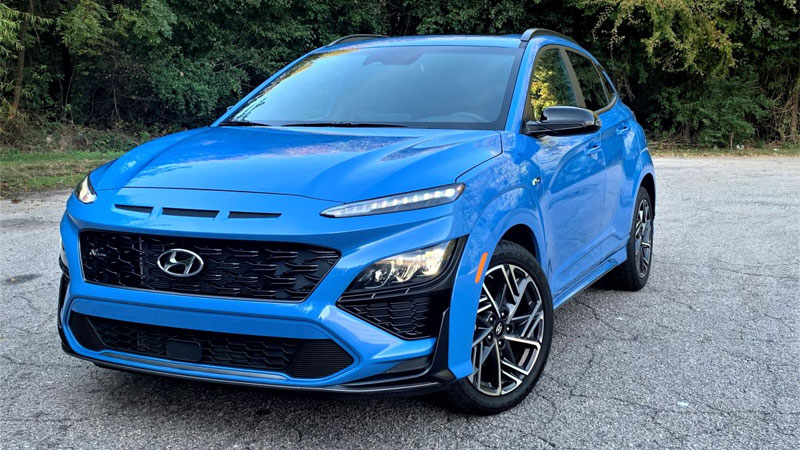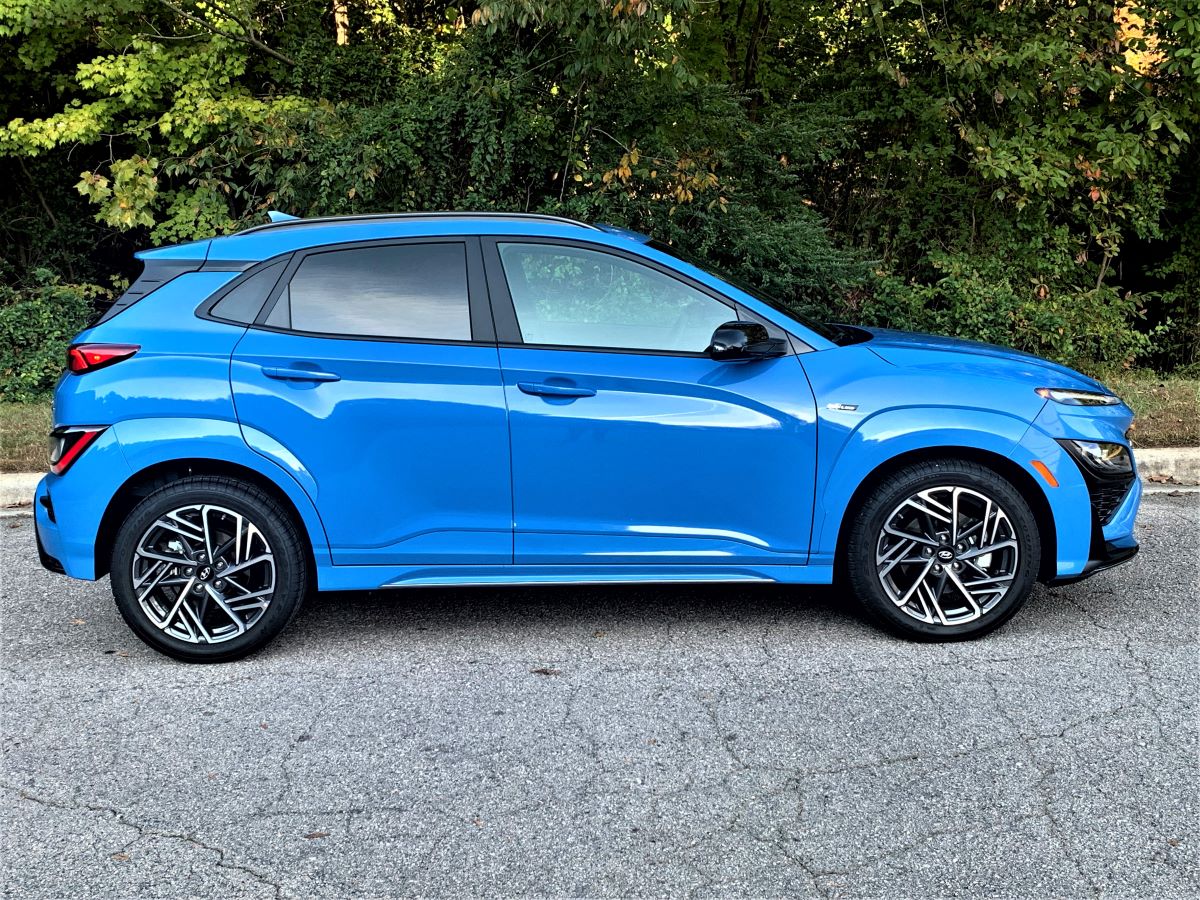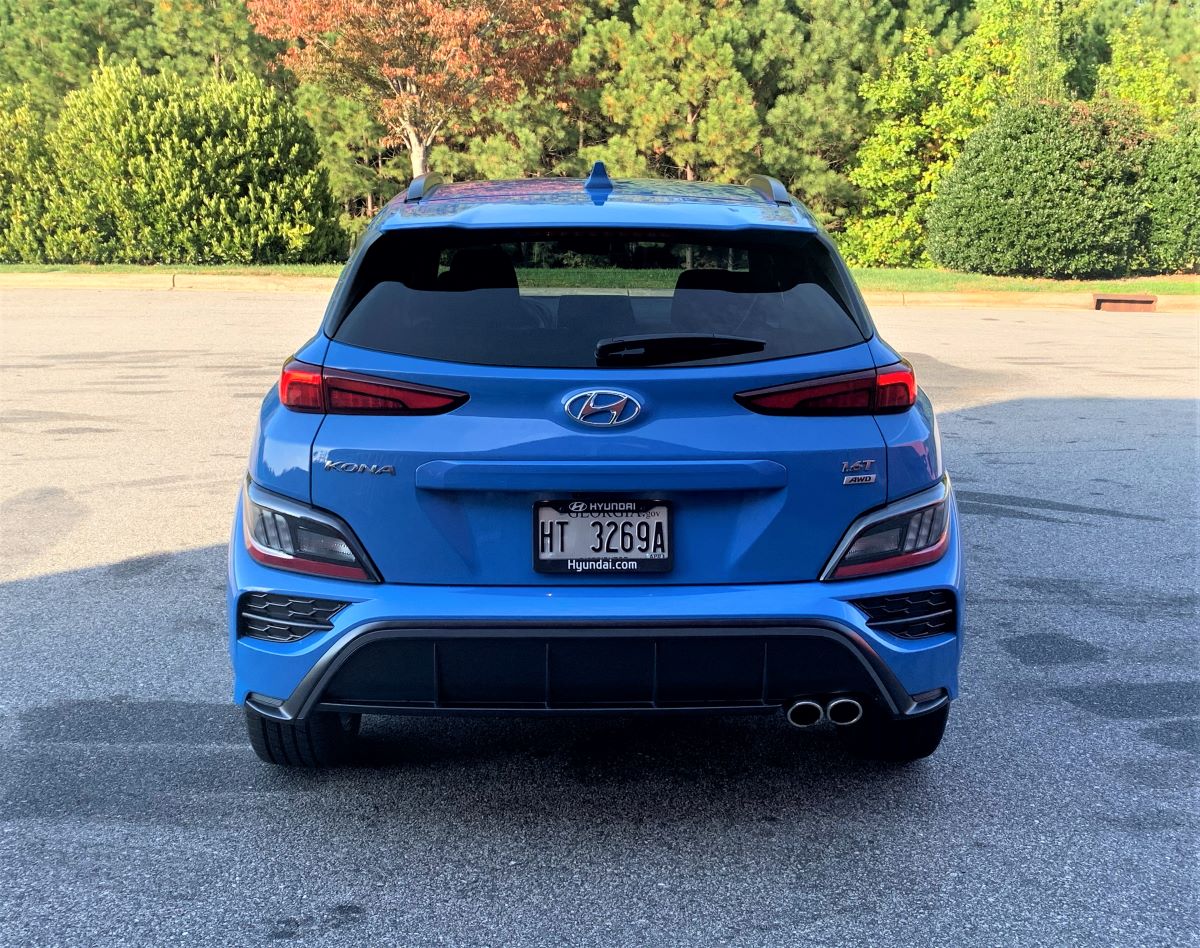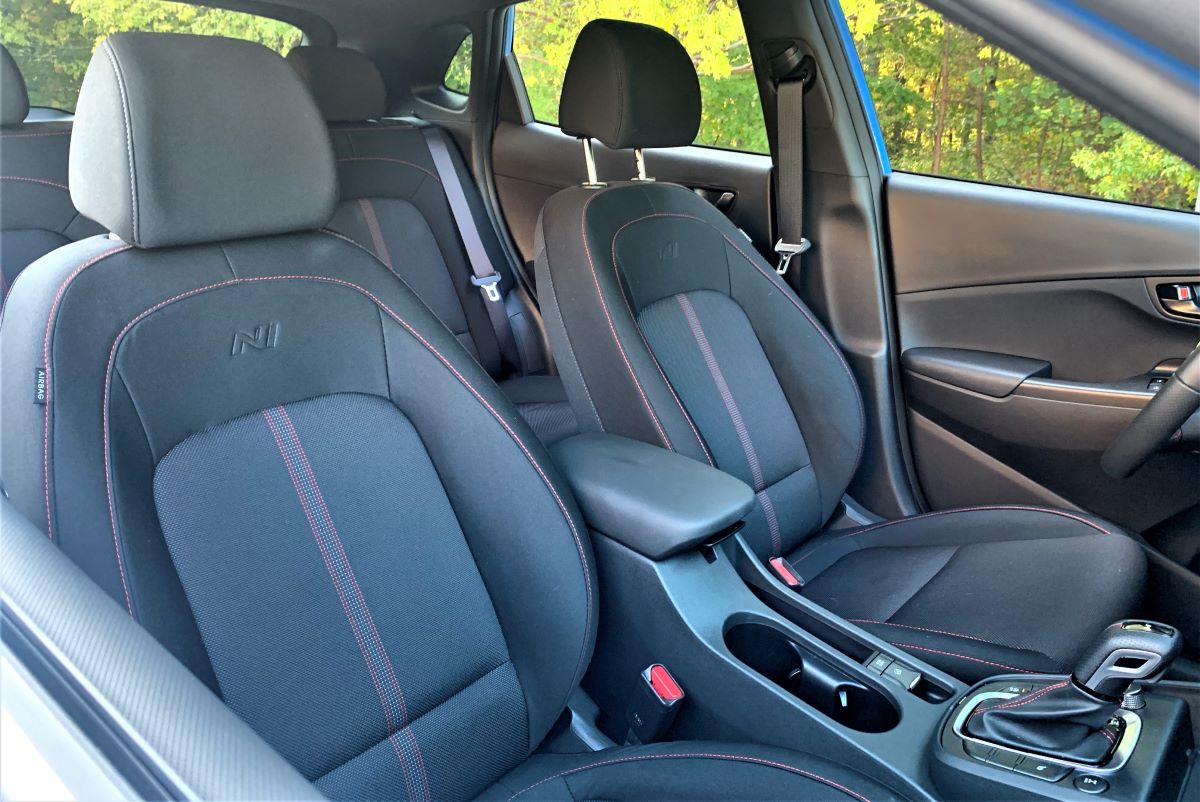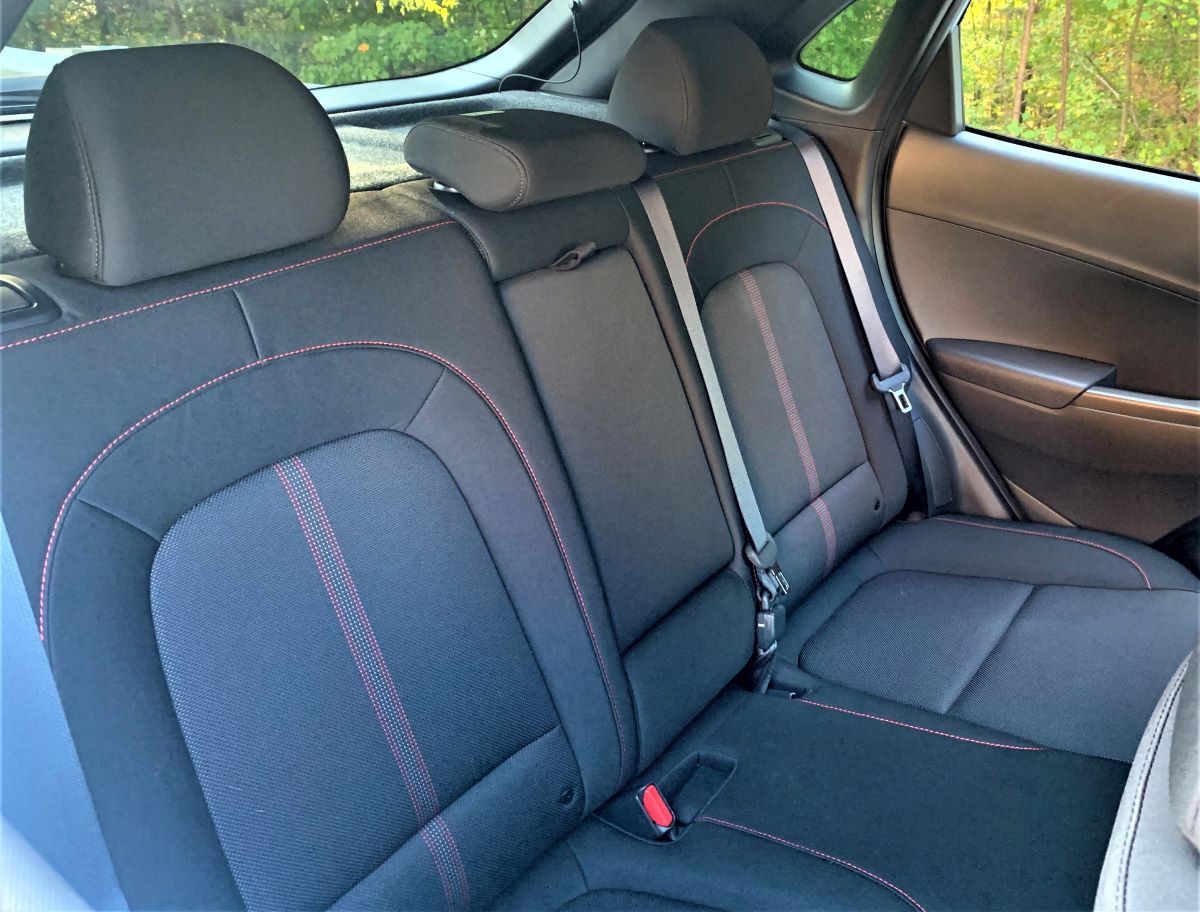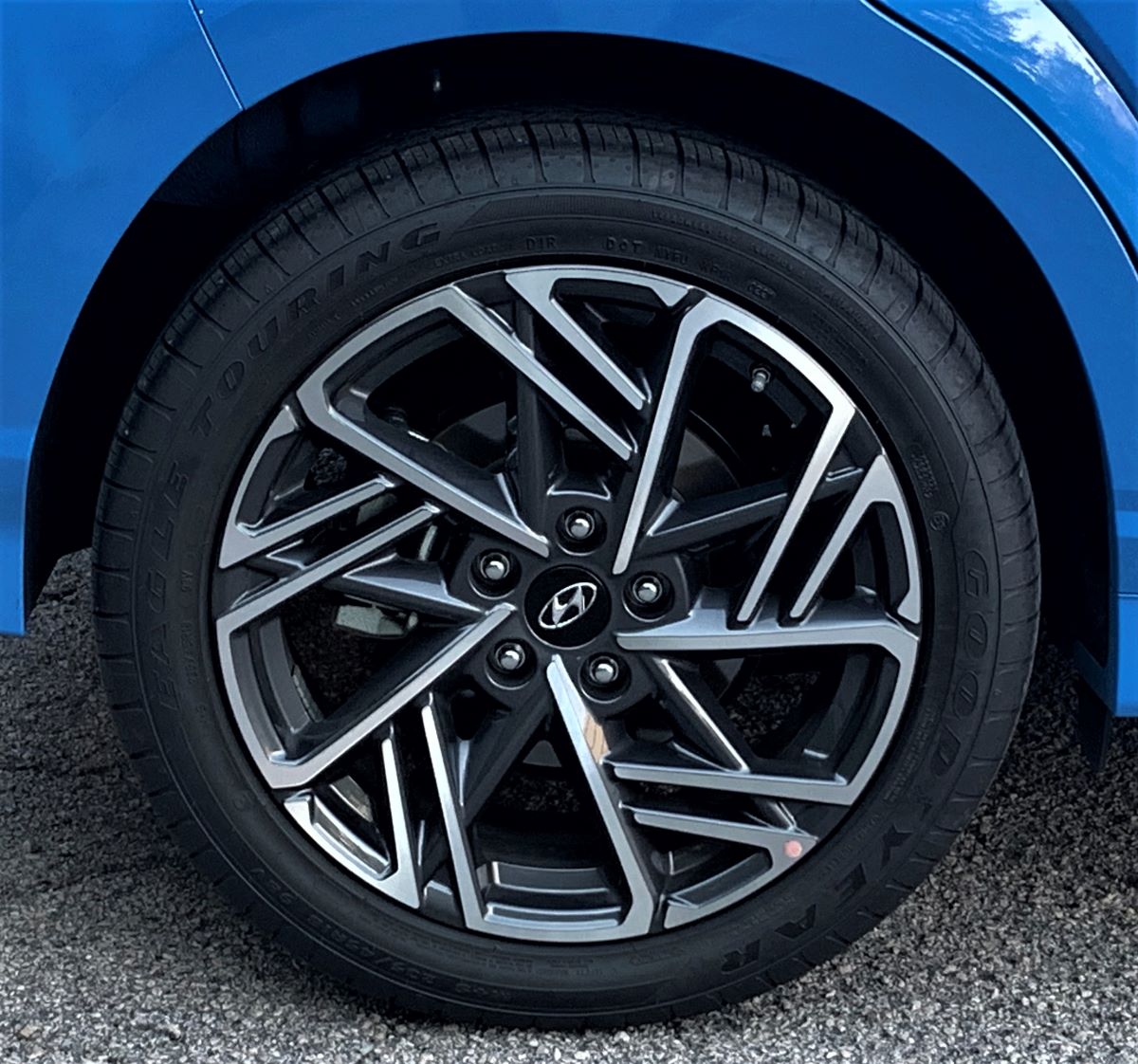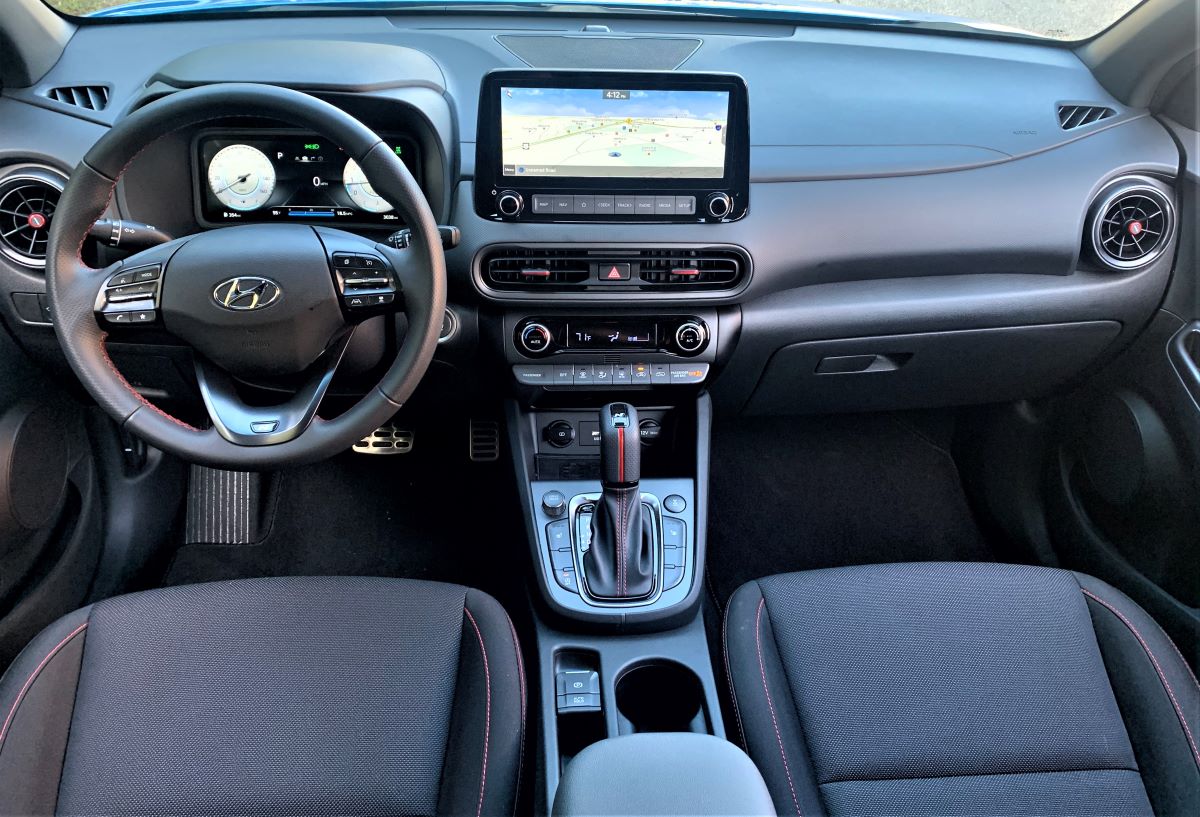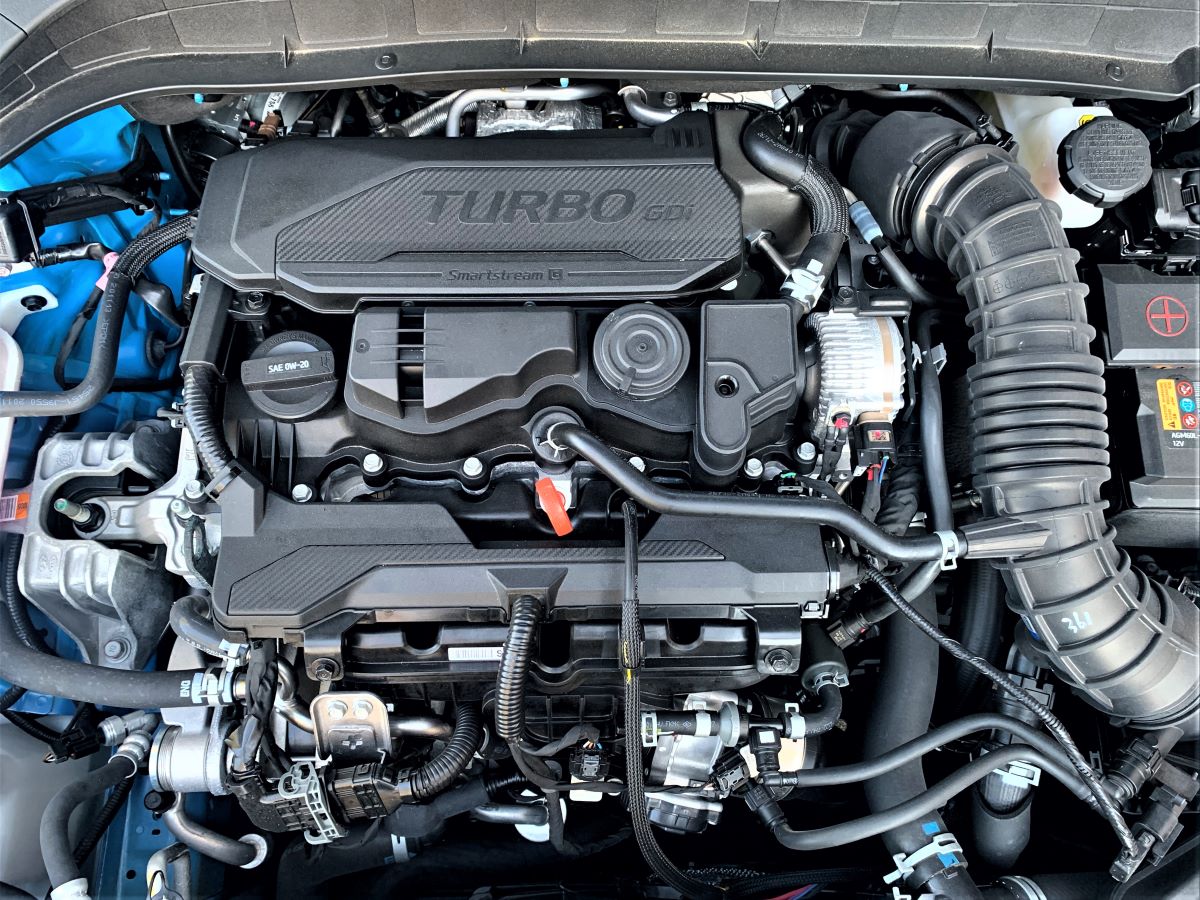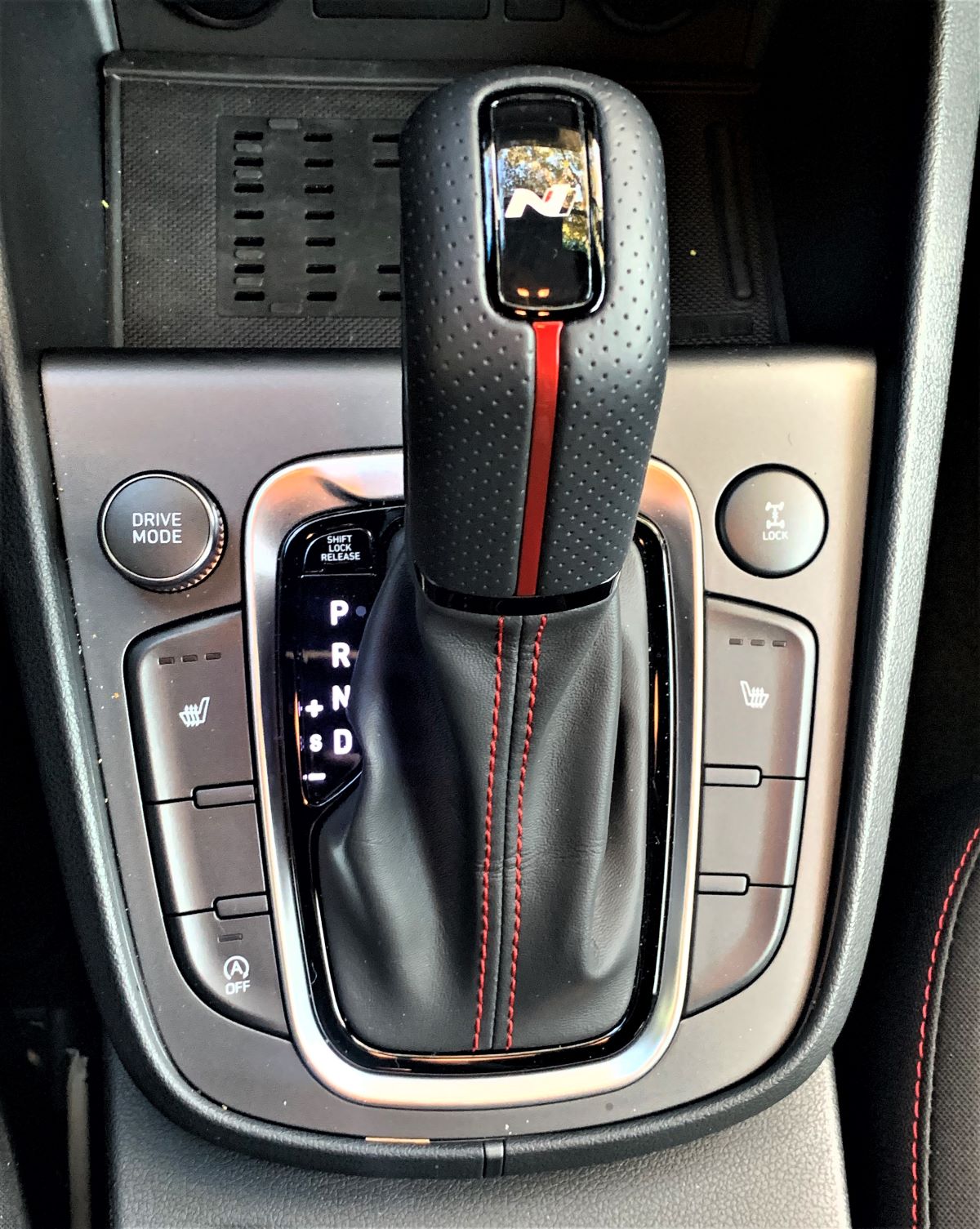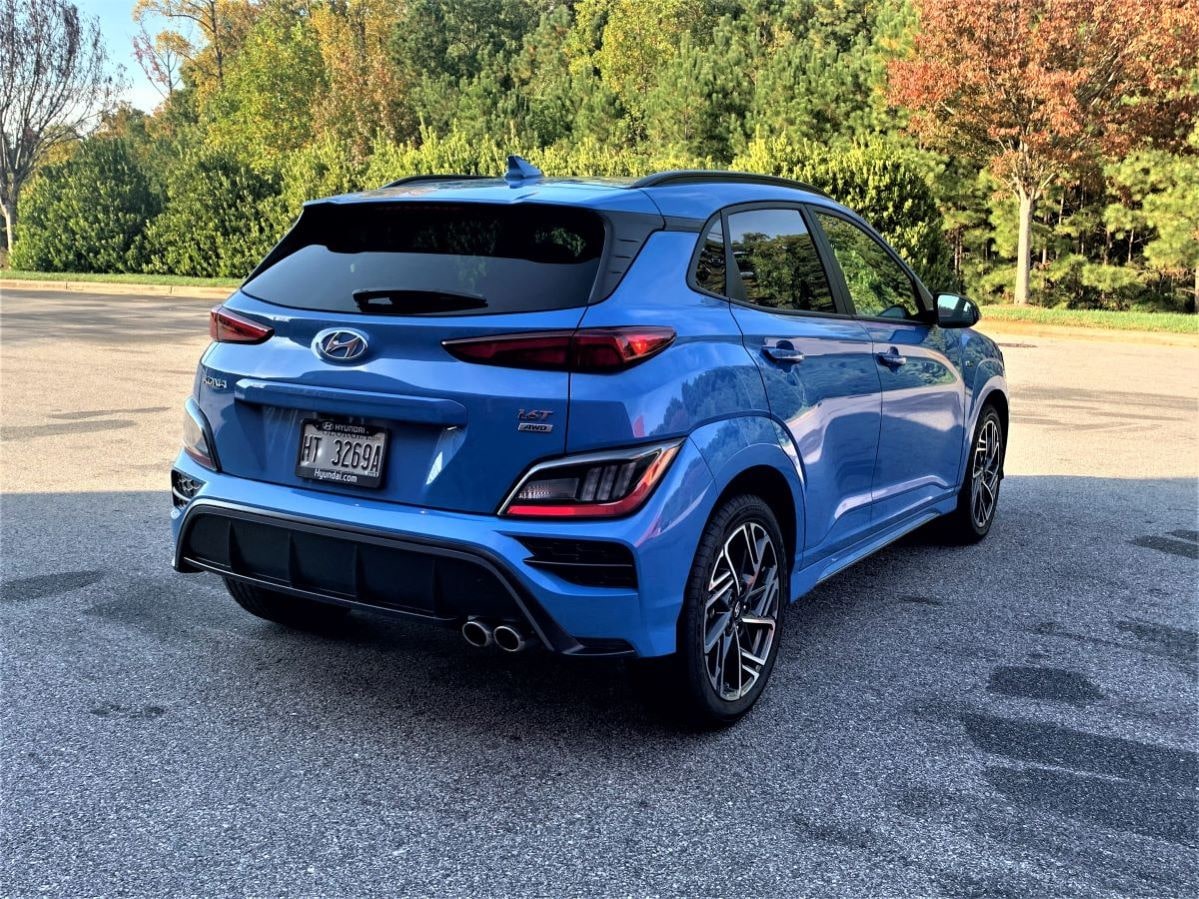The available dual-clutch transmission is a hard pass.
Hyundai is well represented in the tiny crossover utility vehicle market by a pair of subcompacts: the Venue and Kona. Where the Venue seems more like a tall hatchback than a crossover SUV, the Kona is more muscular and with better features.
Our recent weekly driver was a Kona in N Line trim. In a rare occurrence, it is also a model we do not recommend. Please read on for the details.
2022 Hyundai Kona N Line Review
Hyundai offers the 2022 Kona in SE ($21,150), SEL ($22,950), N Line ($25,700), and Limited ($28,450) trims. This quartet comes with standard front-wheel drive or, for a $1,500 upgrade, all-wheel drive. Add $1,225 for the freight charge. Hyundai supplies a pair of engine choices with this model.
Separately, high-performance Kona N and Kona Electric models are offered. The “N” arrives late this calendar year; no pricing is available as of this writing. The Electric model comes in SEL ($34,000) and Limited ($42,500) trims. Buyers may also be eligible for a federal tax credit of up to $7,500.
For 2022, its fifth model year, the Kona benefits from a refresh. An updated exterior, expanded tech and safety features, and a refreshed cabin chart the changes. The N Line and N trims are new this year.
For this review, our focus is on the four main trims.
Exterior Features
The Hyundai Kona is one of the more stylish models in the segment. With much attention to detail, we have a crossover that is at once handsome as it is sporty.
From the front, the beefy grille is offset by deep cutouts housing the available LED fog lamps. The lower grille intake is narrower, but wider. The headlamps represent “slits” where the hood meets the top of the grille. Our N Line model included a trio of breathers (air intakes) just ahead of the hood.
The profile is composed of a series of sweeping character lines, curves, and pronounced body sculpting. The beltline climbs as it moves to the rear where it meets the gently falling roofline.
From the rear, the Kona features a high rear window, triangular tail lamps, and cutouts housing the rear and brake lights. With the N Line, additional ornamentation including a diffuser and twinned tailpipes complete the expression.
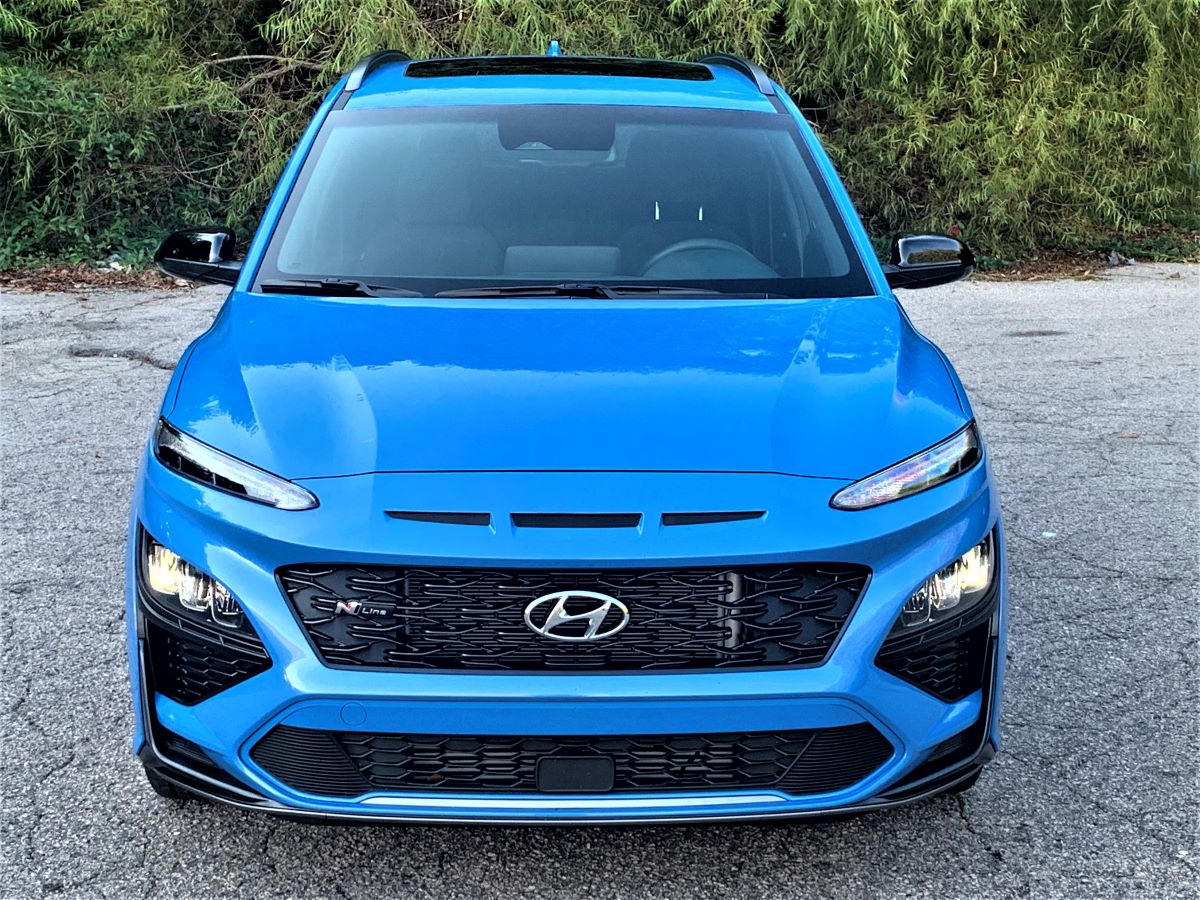
Among the standard features are projector halogen automatic headlights, LED daytime running lights, and 16-inch alloy wheels. Move up through the trim ranks and LED headlights, high-beam assist, LED taillights, and heated side mirrors come in.
Further, the wheel sizes change as well, with 17-, 18-, and 19-inch designs available. Likewise, a power tilt-and-slide sunroof with a sunshade and roof rails are also available.
Interior Highlights
On paper, the Kona seats five, but we advise four. That’s typical for this class. Its design, though, is eye-catching and especially desirous for this segment.
Indeed, just as the exterior features waves of rounded edges, the dashboard does the same. In particular, we find multiple layers, indentations, and character lines. It is far from outlandish, although “active” is one word to describe it.
We like the Kona’s ordered center stack with space for a smartphone at the bottom. Oversized door cutouts hold bottles and goods. Lastly, the small storage compartment underneath the front armrest is handy.
The front seats are more comfortable than the rear and practical for anyone of average size. They’re not very thick and thigh support is average. Nevertheless, we could hardly complain about back pain after a few hours of intense driving.
The 60/40 split fold-down rear bench seat features adjustable head restraints and folds flat. Behind that is 19.2 cubic feet of cargo capacity. Fold down the rear seat and the maximum cargo space measures 45.8 cubic feet. That’s less space than most competitors.
Hyundai equips the Kona with standard full power accessories, a tilt-and-telescopic steering column, air conditioning, and cloth seats. Automatic climate control is available on the SEL and is standard above that.
Additionally, a leather-wrapped steering wheel, ambient lighting, upgraded cloth or full leather-trimmed seats, and a digital instrument panel are available. The 10.25-inch digital panel is certainly a welcome feature with its crisp and adjustable readouts.
Robust Safety Features
The 2022 safety scores for the Hyundai Kona are not yet finalized. But based on last year’s scores, the Kona is a Top Safety Pick recipient from the Insurance Institute for Highway Safety (IIHS). As for the National Highway Traffic Safety Administration (NHTSA), the 2022 Kona earns a 5-star rating, its highest assessment.
All trims come with an assortment of driver-assist technologies. These include forward collision-avoidance assist with pedestrian detection. Lane keep assist, lane following assist, driver attention warning, and rear occupant alert are standard.
Beginning with the SEL trim, the Kona gains blind-spot collision avoidance assist, rear cross-traffic collision avoidance assist, and safe exit warning. The Limited trim adds high-beam assist, parking distance warning – reverse, and highway driving assist.
As for adaptive cruise control, it is optional on the N Line and included with the Limited.
Technology Overview
While the safety tech is quite decent, the in-cabin technologies are even better. Notably, the standard package includes an 8-inch display with a 6-speaker audio system. Two USB ports, wireless Apple CarPlay and Android Auto smartphone compatibility, and Bluetooth are included.
Move up through the trim range and features such as satellite radio and HD Radio come in. A 10.25-inch touchscreen display and a rear USB port are available. Optional with the N Line and standard with the Limited is an 8-speaker Harman Kardon audio system.
As for wireless device charging, it is optional with the SEL and included with the N Line and Limited.
Competitive Set
With plenty of competition, the Kona is hardly alone in its class. Among the other models to consider are the Kia Seltos, Chevrolet Trailblazer, and the Mazda CX-30. Beyond these, the Honda HR-V, Ford EcoSport, and the Subaru Crosstrek are in the running.
The Jeep Renegade, Toyota C-HR and Corolla Cross, Nissan Kicks, Fiat 500X, and Volkswagen Taos are the other models to explore.
Drive Impressions
The 2022 Kona comes with a 2.0-liter four-cylinder engine with 147 horsepower and 132 pound-feet of torque. This engine powers the SE and SEL trims and works with a continuously variable transmission.
The second engine is a 1.6-liter turbocharged four-cylinder engine with an even 195 horsepower and 195 pound-feet of torque. This engine is found in the N Line and Limited trims. Power routes to the wheels utilizing a 7-speed dual-clutch transmission.
Our test N Line supplied direct steering and nimble handling. This model is tossable and generally fun to drive. It reminds us of the Elantra GT hatchback, but with a taller profile. The Elantra GT is gone, but the Kona N Line is a fitting substitute.
But there was a fly in the ointment with our tested N Line. Specifically, the 7-speed DCT. That transmission shuddered frequently in low gear, jerking the car as it shifted between first and second gears. It wasn’t an isolated incident either – it happened at least a dozen times and was witnessed by a family member and a friend.
The DCT problem isn’t new. In fact, Hyundai received complaints several years ago and supposedly fixed them after recalls and updates. But the problem surfaced in our test vehicle and that’s a cause for alarm and dismay.
How does a DCT work? This unit employs a pair of clutches and they are computer controlled. Like a regular automatic, no manual shifting is involved, therefore no clutch pedal is necessary. When they work as designed, DCTs are smoother than manuals and offer better fuel economy.
Indeed, the more powerful turbo model equals the much more sedate standard model in fuel efficiency. Another benefit is that the DCT is supposed to be better in spirited driving.
We found our test model performed admirably at elevated speeds while driving on back, twisty roads. But it was disappointing around town. Again, the shuddering was too obvious to ignore.
One further note: the 7-speed DCT found in some Hyundai and Kia models doesn’t compare to the 8-speed DCT finding its way in other models. The 8-speed is a “wet” DCT, which means it is better suited to handle greater amounts of performance and heat. We reviewed the Kia K5 GT with this transmission in May 2021, explained how it works, and thought favorably of it.
Incidentally, Hyundai and Kia are joined at the hip; the Genesis brand is the luxury marque for Hyundai.
Parting Thoughts
If you are interested in the Kona, stick with the two base trims. That’s unfortunate as the amenities offered with the Limited are quite impressive. But like the N Line, the Limited comes with the objectionable DCT.
We hope Hyundai gets this DCT issue under control soon. Notably, it did not crop up in our test drive of the Riding the N Line With the Hyundai Elantra in August 2021. With that review, we pointed out the earlier DCT problem, believing it had been resolved.
The Kona N Line proves otherwise, thus our recommendation is to avoid models equipped with the DCT.
See Also – Hyundai Goes Electric With the Santa Fe Hybrid
Photos copyright Auto Trends Magazine. All rights reserved.
- 2024 Mazda CX-50: A Compact SUV with Premium Aspirations - Apr 15, 2024
- 2024 Ford Mustang (Iconic Pony Car Evolves) - Apr 4, 2024
- 2024 Ford Maverick (Looks Like a Truck, Drives Like a Car) - Mar 28, 2024

